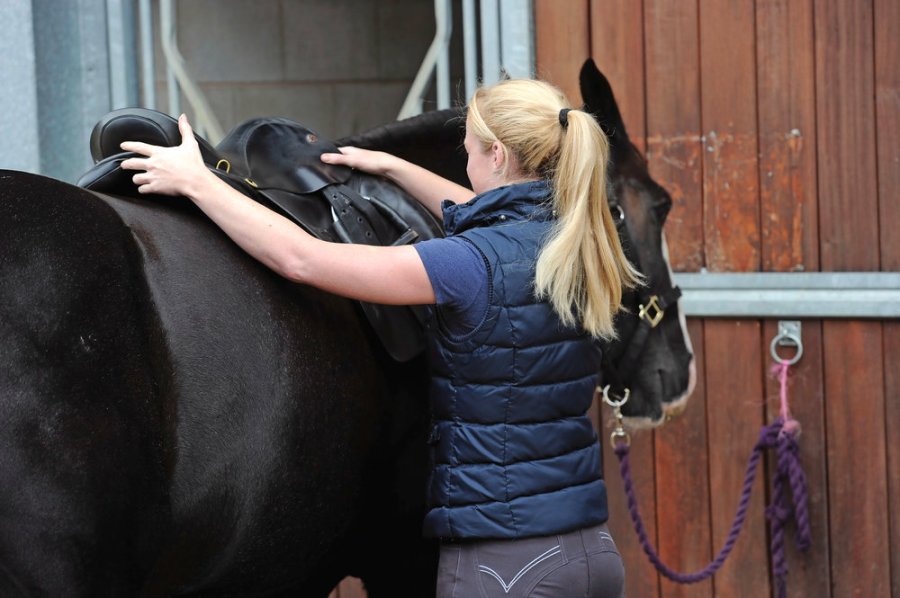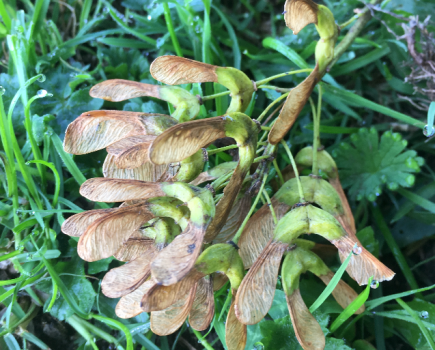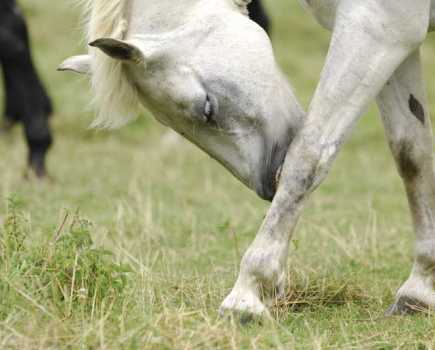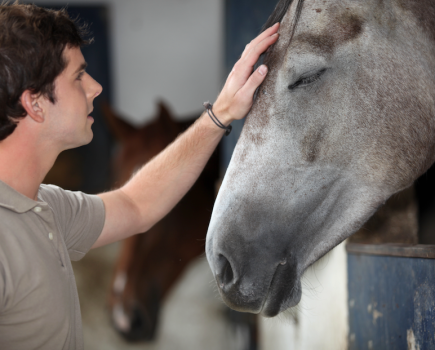Despite having been described in equestrian literature for centuries, there is no single explanation for what a cold-backed horse is actually suffering from. This is because it isn’t a diagnosis, but rather a description of what we are seeing largely in the horse’s behaviour.
There’s a good chance that the first written account in English of a cold-backed horse was authored by the great horsemanship trainer William Cavendish in 1667. He described his approach to ‘restive’ horses, by which he meant those who were unhappy about being worked under saddle. He said that for some of these horses, simply being asked to work forwards on a loose rein was sufficient to ‘reclaim’ them from their restiveness.
A cold-backed horse was defined more recently in a scientific paper as being “a persistent hypersensitivity of the back, with stiffness and dipping (extension) of the back as the rider gets into the saddle. There are usually no other demonstrable clinical signs and no radiographic changes in the thoracolumbar spine. Initial stiffness on being saddled or mounted disappears within a few minutes. No effect on performance is noted thereafter”.
The critical points we can take from this are that ‘cold backs’ are short-lived changes in posture associated with a horse being tacked up and/or mounted. The horse reverts to normal after a period of riding, and a cold-backed horse occurs in those equines who don’t appear to have any problems related to the saddle area.
What causes a cold-backed horse?
Once a cold-backed horse has been ridden for a period, and their ‘cold back’ has warmed up, they will show no further signs of a problem and will work happily. In essence, this can be annoying for the owner, but it isn’t really anything to worry about.
But how do we know whether a horse fits the definition of cold-backed? How do we know they aren’t suffering from something else, and can we really say that having a ‘cold back’ isn’t actually a problem for a horse? It also isn’t always just a case of a postural change. Some affected horses may buck, rear, plunge, kick out or even bolt, which is pretty serious.
In the 1950s, it was generally held that a cold-backed horse dislikes the pressure of a cold saddle being applied to their back, and so warming the saddle first could reduce the chances of bucking.
Although that approach hasn’t continued, it does highlight the saddle as the chief culprit. It goes without saying therefore that the first thing to consider in a horse with an apparent (even transient) back issue when being tacked up is the saddle.
The Society of Master Saddlers maintains a register of qualified saddle fitters who will ensure that your horse’s saddle fits properly. Any parts of the saddle (and girth) that pinch, rub or exert uneven pressures around the horse’s thorax have the potential to produce cold-backed behaviour and should be the first things to eliminate.
Possible triggers of a cold-backed horse
According to research, some horses with kissing spines are said to be cold-backed as “many of these horses may have clinical back pain that eases with exercise”. Without X-rays it’s impossible to distinguish between horses who meet the modern definition of a cold-backed horse and those who have transient back pain due to kissing spines.
The approach to managing these two distinct groups is potentially very different and one may even require surgery, so it’s important to check that a horse really doesn’t have a pathological basis for their exercise-responsive back stiffness before assuming it’s simply a case of being a cold-backed horse.
Kissing spines isn’t the only condition that can spell trouble. Some cases of early vertebral facet joint osteoarthritis can present in a similar manner, and there are also a whole host of non-back problems that can cause horses to act in a cold-backed way when a rider gets on.
Forelimb lameness, including that caused by foot pain, is one such issue, as are dental pain and neck problems, and even internal discomfort, such as gastric ulcers. The only way to rule out these possibilities is for your vet to take a closer look.
Is cold-backed behaviour ‘learned’?
Another possibility is ‘learned’ cold-back behaviour in a horse following episodes of pathological back pain. This could be, for instance, in horses who have suffered acute injury to the supraspinous ligament (this is the ligament that runs along the top of the spine) and have then started ridden work too early.
It seems that these horses ‘learn’ that having a saddle and rider on an injured back genuinely hurts and so they begin to associate being tacked up and mounted with pain.
The danger in this line of thinking is in going a step further and concluding that horses anticipate pain even when it’s no longer there. It would be more astute to ask whether a horse who develops a cold back following recovery from a back injury has not yet fully recovered and is still in pain.
The cold-back conundrum
It is possible that all of the various causes of cold backs share pain as a common factor. If this is the case and a cold back is simply a response to pain, it begs the question as to why these horses seem to work out the problem. If they didn’t, they would just have sore backs (or soreness elsewhere).
Does the pain — wherever it is — go away as the horse works (and, if so, how?), or does warming up the muscles allows the horse to cope more easily with the pain? We simply don’t yet know, but there is little doubt that warmth, relaxation of muscle tension and repetitive gentle movements of joints all help a cold-backed horse to loosen up, move more freely and experience less discomfort.
Beyond the pathological causes (where there is a diagnosable lesion), some non-pathological reasons behind certain cold-backed horses also exist. Any restriction to normal free movement of the rib-sternum and rib-vertebra, or of the facet joints of the thoracic vertebrae in the spine, have the potential to cause a cold-backed horse.
The upside is that they are often correctable using chiropractic, osteopathy and other physical mobilisation techniques. Put simply, if you can restore normal free movement to the joint(s) in question, then the cold-backed behaviour resolves, sometimes for the long term.
These dysfunctions, however, all produce local muscle spasm while they are present (and muscle spasms are uncomfortable), and so there is every chance that this group of horses are similarly demonstrating cold-backed behaviour due to the presence of pain.
8 ways to help a cold-backed horse
The following are various reasons why a horse could be cold-backed, plus tips to help make them more comfortable.
1 Investigate your tack
Is it causing discomfort? Call out a registered saddle fitter to come and check it. Horses change shape all the time, due to age, fitness levels, weight gain/loss, so don’t just get it checked once and then forget about it. Saddle fit should be checked regularly.
2 If symptoms persist, contact your vet
Don’t assume you have a cold-backed horse. There could be an underlying issue causing pain that is treatable. Your vet will consider:
- Lameness
- Primary back pain (such as from kissing spines)
- Dental problems
- Internal discomfort, such as gastric ulcers
3 Explore other options
Your vet may suggest looking at pain relief via medication or acupuncture.
4 Look for other causes
Where there doesn’t appear to be a pathological basis for the behaviour of a cold-backed horse, the next step is to look for more functional causes. Physiotherapy, osteopathy and chiropractic may assist with identifying and addressing the issue. Even where pathology has been identified, these treatment methods are likely to be able to play helpful roles in the management of a cold-backed horse.
5 Warm a cold-backed horse’s back up first
Do all you can to support your horse and don’t just rely on them working through their cold back every time you ride. Experts may no longer advocate warming saddles, but warming your horse’s back will be beneficial. A solarium is the obvious way, however heat pads and blood-temperature hot water bottles can work just as well, and there’s also an argument for old fashioned body-brush strapping if your horse will tolerate it. Keeping the horse’s back covered with a rug while grooming and tacking up may help too.
6 Encourage the horse to stretch before riding
Various pre-ride stretches can be very useful and massages often go down well, too. Here are two easy stretches to try.
7 Tack up slowly
Taking extra time to tack up and doing up the girth slowly will benefit many horses. Developing a strategy for the beginning of every ridden work session will help too.
8 Delay mounting
Some riders of a cold-backed horse have reportedly had success with lightly lunging a horse before being mounting, using a horse walker or walking around in-hand. It’s worth a try, to see what works for your horse.









